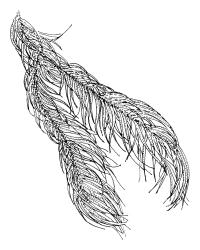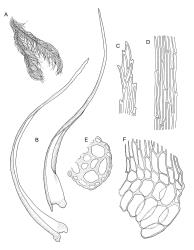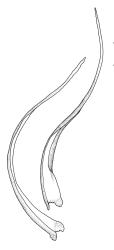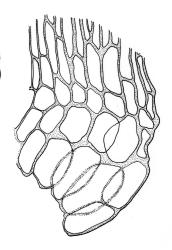Plants medium-sized, gold- or yellow-green, lustrous, forming densely interwoven and apparently pendent mats. Stems c. 15–20 mm, branching irregularly and sparsely by forking, dark brown, with very sparse, pale brown, and smooth rhizoids arising singly in leaf axils; in cross-section c. 6 cells across, with a single layer of weakly differentiated cortical cells, surrounding larger (c. 30 μm diam.) internal cells, and no central strand. Leaves falcate-secund, little altered when dry, narrowly lanceolate and tapered to long filiform-acuminate apices, ecostate, entire below, serrate to ± spinose at apex, not bordered, tubulose ± throughout, mostly (3.5–)3.7–4.0(–4.5) × 0.25–0.35(–0.40) mm (under coverslip). Mid laminal cells (upper third of leaf) linear, smooth or slightly prorulate, non-porose, unistratose throughout, with thick longitudinal walls and mostly thin transverse walls, c. 75–115 × c. 4 μm, becoming ± thicker-walled and ± porose in the lower leaf; basal cells unistratose, brown, thick-walled and ± porose in a few rows extending between the alar groups; alar group strongly defined, of c. 12–15 enlarged, hyaline or weakly pigmented, unistratose, and relatively thin-walled cells (the largest c. 40 × 20 μm), extending c. ⅓ across the leaf base and usually 3–4 cells up the margin, with a few (usually c. 6–10) supra-alar cells irregular, thick-walled, and grading into cells of the lower lamina. Axillary hairs apparently absent. Paraphyllia absent.
Sexuality and sporophytes unknown.
Fife 2012, figs 1, 2 A–C.
SI: Southland (Resolution I.), St (Pegasus Creek, Tin Range).
Endemic.
The type collection, made by P.J. Brownsey from Resolution I., occurred on a dripping wet, vertical rock face in a forest clearing within mountain beech/kamahi/rimu forest at close to sea level. Elevation data from the Stewart I. collections are scant. The collections from there are mostly from streamside rocks. One of the Pegasus Creek collections (probably from near Belltopper Falls) was from "sea level" while the Tin Range (the source of Pegasus Creek) collection came from "summit bogs". The highest summit in the Tin Range is over 600 m elevation. Three ample collections made by Martin in the Tin Range/Pegasus Creek area suggest that the species was relatively common at this locality when he visited in 1949.
Associated bryophyte species isolated from the type collection are Andreaea subulata, Isotachis lyallii, and Telaranea patentissima. Hepatics isolated from the Stewart I. paratypes are Cryptochila grandifolia, Lepidozia kirkii, Riccardia nitida, and Telaranea patentissima.
Relative to other species of Sematophyllum occurring in New Zealand and temperate Australia, S. fiordensis is distinguished primarily by its very long (mostly 3.7–4.0 mm), narrow, and strongly falcate-secund leaves. The near absence of thickened cortical cells in the stems, and the tubulose, narrowly lanceolate leaves tapered to long filiform-acuminate apices are anomalous in Sematophyllum. If sexual structures and capsules are eventually found, the removal of this species from Sematophyllum may prove justified.
A few ovate and acute foliose (c. 500–700 × 200 μm) structures at the base of branches occur. Since they have slightly inflated alar cells these structures have been interpreted as reduced leaves rather than as pseudoparaphyllia.
Among the other N.Z. species of Sematophyllum, S. fiordensis could only be confused with S. uncinatum, a far more common species that grows in similarly irrigated habitats. Sematophyllum uncinatum is a less lustrous plant with much shorter, broader (c. 1.8–2.5 × 0.45–0.70 mm), and more abruptly tapered leaves. It frequently fruits. The internal stem anatomy differs markedly between the two species, with the stems of S. uncinatum being 16 or more cells across, and with 3–4 well-differentiated and thick-walled cortical cell layers.
The strongly lustrous, narrowly lanceolate, and falcate-secund leaves of S. fiordensis are suggestive of a sterile Blindia. But in addition to the aforementioned branching pattern, the absence of both a costa and a central strand precludes confusion.










